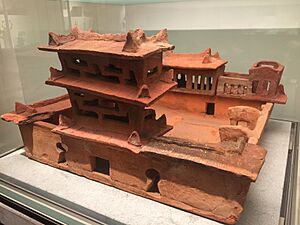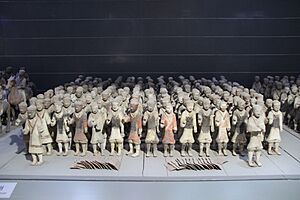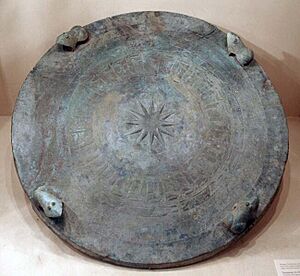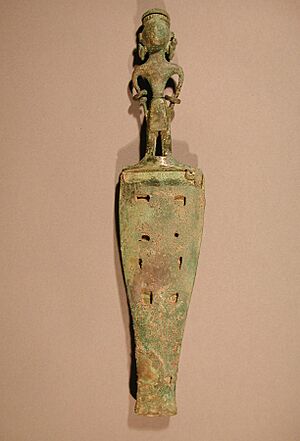Trung sisters' rebellion facts for kids
Quick facts for kids Trung sisters' rebellion |
|||||||
|---|---|---|---|---|---|---|---|
| Part of the southward expansion of the Han dynasty | |||||||
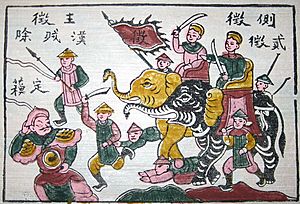 The Trung sisters' rebellion depicted in a Đông Hồ folk painting titled "Trưng Vuơng trừ giặc Hán" (徴王除賊漢 - Trung Queens eliminating the Han enemies). Trưng Trắc (徴側) sits on white elephant and Trưng Nhị (徴貳) on black elephant, accompanied by weapon-toting Lạc Việt soldiers; Han soldiers are felled and dead; Han governor Su Ding (蘇定) looks back while fleeing. All wear anachronistic clothing. |
|||||||
|
|||||||
| Belligerents | |||||||
| Han dynasty | Lac Viet | ||||||
| Commanders and leaders | |||||||
| Su Ding (Governor) Ma Yuan Liu Long |
Trưng Trắc Trưng Nhị Đô Dương Chu Bá |
||||||
| Strength | |||||||
| 20,000 soldiers 2,000 tower-ships |
unknown | ||||||
| Casualties and losses | |||||||
| 40–50% of Han soldiers (mostly from epidemic) | Trưng sisters' forces: • several tens to hundreds killed; • over 20,000 surrendered Đô Dương's forces: • over 5,000 (both killed and surrendered); • over 300 exiled Chu Bá's forces: • several tens to hundreds executed |
||||||
The Trưng sisters' rebellion was a big uprising in what is now Northern Vietnam. It happened between 40 CE and 43 CE. Two brave sisters, Trưng Trắc and Trưng Nhị, led the Luoyue people against the Chinese rulers. In 42 CE, the Han Empire sent a strong army to stop the rebellion. By 43 CE, the Han army had won. The Trưng sisters were captured and executed. However, some Vietnamese stories say they chose to jump into the Hát Giang river instead of giving up.
Contents
Why the Rebellion Started
Long ago, the people in Northern Vietnam were called the Lac Viet or Luoyue. They had their own unique ways of life. They practiced matrilineality, meaning women had an important role in families and could own land. They also had special customs like facial tattooing.
Chinese immigrants started to move into the area. Chinese governors tried to change the local ways. They introduced Chinese-style marriage and opened Chinese schools. This caused problems because it clashed with the local traditions. For example, Chinese marriage customs could change who owned land, which was different from the Lac Viet's matrilineal system.
The Trưng sisters came from a rich and important Lac Viet family. Their father was a local leader. Trưng Trắc's husband, Thi Sách, was also a Lac lord. The Chinese governor, Su Ding, was known for being very harsh. He tried to control Thi Sách with strict laws. Trưng Trắc was a strong and brave woman. She encouraged her husband and other Lac lords to fight back against the Chinese rule.
The Uprising Begins
In March of 40 CE, Trưng Trắc and her younger sister Trưng Nhị led the Lac Viet people in a rebellion against the Han. Some stories say Trưng Trắc started the fight to get revenge for her husband's death. Other stories suggest it was also about protecting their land rights.
The rebellion began in the Red River Delta. Soon, it spread to many other Lac tribes and non-Han people. They took control of about sixty-five towns. Trưng Trắc was declared queen. Even though they controlled the countryside, they couldn't capture the main fortified Chinese towns.
The Han Fight Back
The Han government, located far away in Luoyang, was slow to react at first. But in 41 CE, the Han Emperor ordered a military campaign. They sent their best generals, Ma Yuan and Duan Zhi, to stop the rebellion. Ma Yuan was given the special title "General who Calms the Waves."
Ma Yuan gathered a large Han army. It had 20,000 regular soldiers and 12,000 local helpers. He also sent many supply ships along the coast.
In the spring of 42 CE, the Han army reached Lãng Bạc. Ma Yuan's forces fought the Trưng sisters' army. They killed thousands of rebels, and more than ten thousand surrendered. The Chinese general kept pushing forward. The Chinese captured both sisters in early 43 CE. The rebellion was fully stopped by April or May 43 CE. Ma Yuan had Trưng Trắc and Trưng Nhị executed. By the end of 43 CE, the Han army had full control of the region.
What Happened Next
After winning, the Han forces killed many of the Lac Viet leaders. They also moved hundreds of families to China. Ma Yuan spent much of 43 CE setting up Han rule in the Red River Delta. He tried to make the local people more like the Chinese. He even melted down the Lac bronze drums, which were symbols of local power. He used the bronze to make a statue of a horse for the Chinese Emperor.
The defeat of the Trưng sisters also marked the end of the Dong Son culture in Northern Vietnam. This culture was famous for its bronze drums. The Han tightened their control, and local leaders started to adopt Chinese ways. Chinese techniques, religions, and taxes were introduced.
This region gradually became part of the Chinese empires. There were no major uprisings for about 400 years. The Han victory also helped China connect with trade routes to Southeast Asia and beyond. This led to more trade and the spread of ideas, like Buddhism, to China.
The Legacy of the Trưng Sisters
The Trưng sisters' rebellion showed how important women were in early Vietnamese society. Some old scholars blamed the defeat on women leading the fight. However, modern Vietnamese historians praise the sisters for their courage. They highlight how these "mere girls" stood up when men did not.
There's a famous Vietnamese saying: Giặc đến nhà, đàn bà cũng đánh. This means "when the enemy is at the gate, even the women go out fighting." It is often used to show the respected status of Lac women. However, some people interpret it differently. They say it means fighting is not usually for women, but they will fight if their home is in extreme danger.
See also
- Lady Triệu
- Phùng Thị Chính
- Copper columns of Ma Yuan
- Bùi Thị Xuân
- Matriarchy
- Feminism


